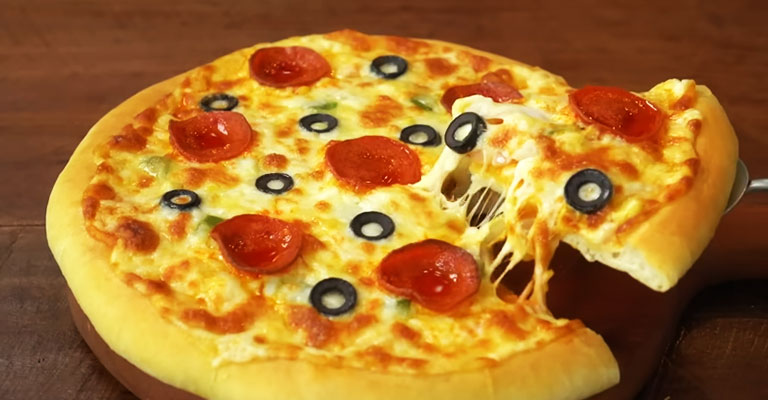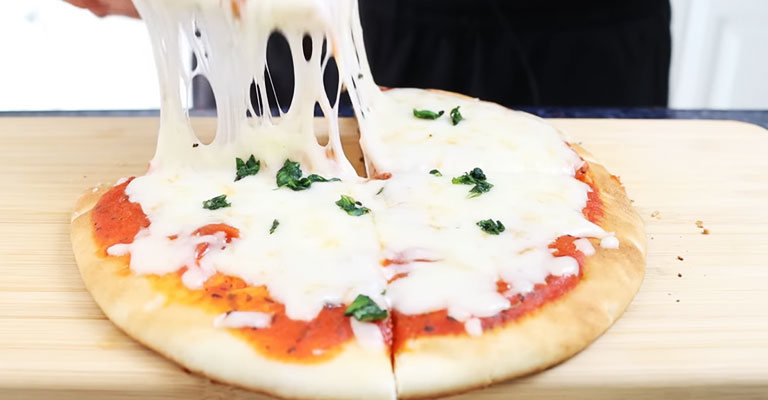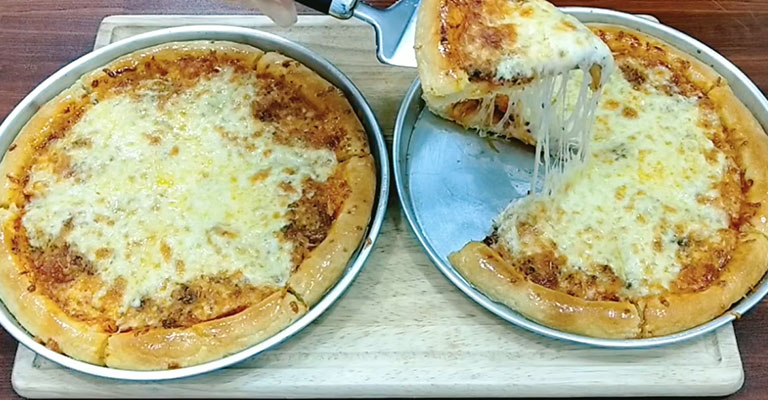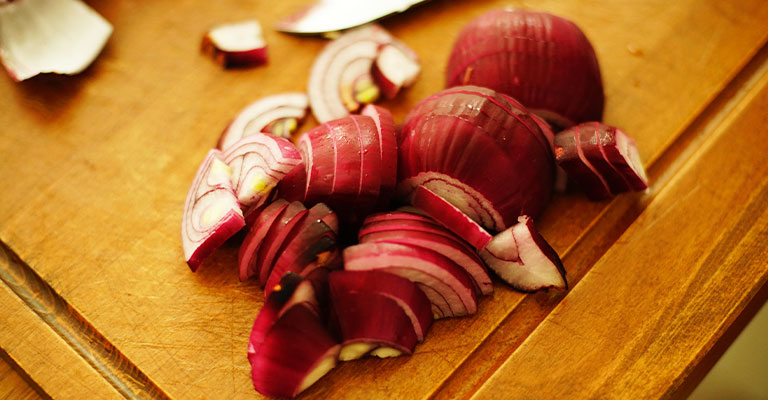Why Cheese Is Not Melting On Pizza?-Factors and Implications
The enigma of cheese’s elusive melt on pizza. Achieving that golden, bubbling perfection is a culinary pursuit that involves a symphony of elements.
From the choice of cheese, where moisture content reigns supreme, to the precision of slicing or grating, every step plays a crucial role.
Oven temperature, often underestimated, becomes the stage where cheese transforms from solid to molten bliss. Overloading with toppings or using processed variants can disrupt this delicate dance.
Quality, too, holds sway, as pure, unadulterated cheeses yield the most satisfying melt. Join us in unraveling the secrets behind that coveted, gooey cheese crown atop the perfect pizza.

Why Cheese Is Not Melting On Pizza?
Cheese not melting properly on pizza can be a common culinary conundrum, and it’s essential to understand the various factors that can contribute to this issue.
While melted cheese is a crucial element of a delicious pizza, several reasons can lead to cheese not achieving the desired gooey, golden, and bubbling consistency:
Cheese Quality
The type and quality of cheese used on a pizza can significantly impact its melting properties.
Low-quality or processed cheeses may contain additives and stabilizers that hinder the melting process. Opt for high-quality, fresh cheeses like mozzarella for the best results.
Moisture Content
Cheese with excessive moisture can release water during baking, preventing proper melting.
Fresh mozzarella, for instance, should be drained and dried before being used on pizza to remove excess moisture.
Thickness of Cheese Slices
Slicing cheese too thickly can lead to uneven melting. Thinly slicing the cheese or using grated cheese distributes heat more evenly and ensures a smoother melt.
Baking Temperature
A key factor in achieving perfectly melted cheese on a pizza is the oven temperature.
A hot oven, typically around 475-550°F (245-290°C), is essential to create the ideal conditions for the cheese to melt and become bubbly and golden.
Preheating the Oven
Not preheating your oven adequately can lead to uneven cooking.
The oven should be preheated to the desired temperature to ensure that the pizza cooks evenly and the cheese melts correctly.
Placement of the Pizza
Placing the pizza on a lower rack in the oven can help ensure that the cheese melts properly.
This allows the heat to circulate around the pizza, cooking it evenly and allowing the cheese to melt as it should.
Overloading with Toppings
Overloading your pizza with toppings can lead to an uneven distribution of heat. Too many toppings can trap moisture, making it difficult for the cheese to melt properly.
Par-Baking the Crust
Par-baking the pizza crust for a few minutes before adding the cheese and toppings can help ensure that the cheese melts evenly.
This prevents the crust from cooking too quickly while the cheese remains unmelted.
Oven Placement
Sometimes, the type of oven or its placement can affect cheese melting. If using a pizza stone or steel, ensure it’s preheated properly to create an even cooking surface. Oven placement and ventilation can also impact the melting process.
Cheese Type
Different cheeses have different melting properties. For instance, mozzarella and provolone are known for their excellent melting abilities, while harder cheeses like Parmesan may not melt as smoothly.
Types of Cheese and Melting Properties

Different types of cheese have varying melting properties due to their unique composition of proteins, fats, and moisture content.
Here are some common types of cheese and their melting properties:
Mozzarella
Mozzarella cheese is perhaps the most popular cheese for pizza due to its excellent melting properties.
It becomes gooey, stretchy, and browned when exposed to heat. Fresh mozzarella is high in moisture and creates a creamy texture when melted.
Cheddar
Cheddar cheese melts well, but it has a tendency to become oily when overcooked. It’s commonly used in dishes like macaroni and cheese and grilled cheese sandwiches.
Provolone
Provolone cheese melts nicely and has a creamy, smooth texture. It adds a rich, tangy flavor when melted and is often used in sandwiches and hot dishes.
Swiss
Swiss cheese melts relatively well, and it’s known for its characteristic holes or “eyes.” It has a mild, nutty flavor when melted and is commonly used in dishes like Swiss cheese fondue.
Gruyère
Gruyère cheese melts smoothly and is often used in dishes like quiches, gratins, and French onion soup. It has a rich, slightly sweet flavor when melted.
Parmesan
Parmesan cheese, especially aged Parmigiano-Reggiano, does not melt well in the same way that mozzarella does.
It tends to become crisp and golden when exposed to heat and is often used as a topping for dishes like pasta and salads.
Blue Cheese
Blue cheeses, such as Roquefort and Gorgonzola, can be melted but often retain their crumbly texture. They are typically used in salad dressings or as a topping for burgers and steaks.
Cream Cheese
Cream cheese melts smoothly and is commonly used in creamy sauces, cheesecakes, and dessert recipes. It contributes a rich, creamy texture when melted.
Brie
Brie cheese melts beautifully, becoming creamy and gooey while maintaining its mild, buttery flavor. It’s often used in baked dishes or as a topping for bread.
Feta
Feta cheese does not melt well and retains its crumbly texture when heated. It’s best used as a topping for salads, baked dishes, or in Mediterranean-style recipes.
Havarti
Havarti cheese melts nicely, creating a creamy texture. It’s often used in grilled cheese sandwiches and melts well in omelets and quiches.
Troubleshooting Non-Melting Cheese

When you’re experiencing issues with cheese not melting as expected, there are several potential causes and corresponding solutions to consider.
Here are some common problems and their respective remedies:
Insufficient Heat
- Cause: The oven or cooking surface may not be hot enough to melt the cheese properly.
- Solution: Preheat the oven or cooking surface to the recommended temperature for the type of cheese you’re using. For example, most pizzas are baked at temperatures between 475-550°F (245-290°C) to ensure proper melting.
Using the Wrong Type of Cheese
- Cause: Some cheeses don’t melt well due to their low moisture content, high fat content, or specific protein structure.
- Solution: Choose cheeses that are known for their melting properties, such as mozzarella, provolone, or cheddar. Avoid using cheeses like Parmesan or feta, which tend to hold their shape when heated.
Using Pre-Shredded Cheese
- Cause: Pre-shredded cheese often contains anti-caking agents, which can hinder melting.
- Solution: Grate or slice your own cheese from a block to ensure optimal melting. If you must use pre-shredded, look for varieties without added anti-caking agents.
Too Much Moisture
- Cause: Excess moisture from ingredients like tomatoes or fresh vegetables can inhibit melting.
- Solution: Pat down moist ingredients with a paper towel before adding the cheese. Pre-cooking or draining ingredients like tomatoes can also help reduce excess moisture.
Incorrect Cheese Thickness
- Cause: Slicing the cheese too thickly can lead to uneven melting.
- Solution: Thinly slice or grate the cheese to ensure even distribution and quicker melting.
Overloading with Toppings
- Cause: Too many toppings can trap heat and prevent the cheese from melting evenly.
- Solution: Use a moderate amount of toppings and ensure they are evenly spread across the pizza or dish.
Using Cold Cheese
- Cause: Cold cheese takes longer to melt and may not achieve the desired texture.
- Solution: Allow the cheese to come to room temperature before using it. This can help it melt more evenly and quickly.
Baking Time and Temperature
- Cause: The cheese may not have enough time to melt properly, or the temperature may be too low.
- Solution: Ensure that you follow the recipe’s recommended baking time and temperature. Adjust if necessary based on your specific oven’s performance.
Using Aged or Hard Cheeses
- Cause: Aged or hard cheeses like Parmesan have a lower moisture content and don’t melt well.
- Solution: Use these cheeses primarily as a finishing touch, grated on top of a dish, rather than relying on them for melting.
Not Using the Right Cheese for the Dish
- Cause: Some cheeses are better suited for specific dishes. Using the wrong cheese for the application can lead to non-melting.
- Solution: Choose cheeses based on their intended use. For example, use mozzarella for pizza, cheddar for grilled cheese, and Parmesan for sprinkling on pasta.
Cheese Alternatives for Situations Where Melting Is Not Desired
Sometimes, you may encounter situations where you don’t want your cheese to melt but still desire a cheese-like flavor or texture. In such cases, cheese alternatives can be a great solution.
Here are some options for non-melting cheese alternatives:
Vegan Cheese
Many vegan cheeses are designed to mimic the flavor and texture of traditional dairy cheese without melting excessively.
They come in various forms, including slices, shreds, and blocks. Look for brands that specialize in producing non-melting varieties.
Nut-Based Cheeses
Cheeses made from nuts, such as cashews or almonds, can provide a creamy and slightly crumbly texture without melting when heated. These are often used in vegan and dairy-free recipes.
Tofu-Based Cheese
Tofu can be blended with various flavorings to create a cheese-like consistency that remains stable when heated. It’s a common choice for vegan and dairy-free cooking.
Cream Cheese Alternatives
Non-dairy cream cheese alternatives are available and can be used in recipes where you need a creamy, non-melting cheese substitute.
Soft Spreads
Some non-dairy cheese alternatives come in soft, spreadable forms, similar to cream cheese. They can be used in dips, spreads, and as a condiment.
Nutritional Yeast
Nutritional yeast has a cheesy, nutty flavor and can be sprinkled on dishes to add a cheesy taste without melting. It’s often used on popcorn, pasta, and in sauces.
Dairy-Free Parmesan
You can find dairy-free Parmesan alternatives made from ingredients like cashews and nutritional yeast. These add a cheesy flavor to dishes without melting.
Tips for Proper Cheese Melting

Properly melting cheese is a fundamental culinary skill that can enhance the flavor and texture of various dishes.
Whether you’re making a gooey grilled cheese sandwich, a creamy mac and cheese, or a perfectly melted pizza, knowing how to melt cheese effectively is essential.
Here are some tips for achieving that perfect, melty cheese:
Choose the Right Cheese
Not all cheeses are created equal when it comes to melting. Opt for cheeses known for their superior melting properties, such as mozzarella, provolone, or cheddar.
These varieties contain the right balance of fats and moisture for that creamy, gooey texture.
Grate or Slice Appropriately
The thickness of your cheese slices or the fineness of your grating can greatly affect melting.
Thin slices or finely grated cheese will melt more evenly and quickly than thick chunks.
Preheat Your Oven or Pan
Before placing your dish in the oven or on the stovetop, make sure it’s properly preheated.
This ensures that the cheese starts melting as soon as it hits the heat, leading to a smooth, uniform texture.
Pat Down Moist Ingredients
Excess moisture from ingredients like tomatoes or fresh vegetables can hinder proper melting.
Patting them down with a paper towel before adding the cheese can help eliminate this issue.
Avoid Overloading with Toppings
While a mountain of toppings may seem appealing, it can hinder the cheese’s ability to melt evenly.
Use a balanced amount of toppings to allow the cheese to melt and integrate seamlessly with the other ingredients.
Incorporate Low-Moisture Cheeses
Combining low-moisture cheeses, like Parmesan or Romano, with high-moisture cheeses can help create a balanced melt.
The low-moisture cheese adds flavor without compromising the overall texture.
Monitor Baking Time and Temperature
Following the recommended baking time and temperature for your specific recipe is crucial.
This ensures the cheese has enough time to melt properly without burning or becoming too runny.
Experiment with Cheese Blends
Mixing different types of cheeses can enhance the flavor and melting properties. For example, a blend of sharp cheddar and creamy Monterey Jack can create a rich, velvety melt.
Let Cheese Come to Room Temperature
Allowing cheese to come to room temperature before using it in a recipe can help it melt more evenly. Cold cheese takes longer to melt and may not achieve the desired texture.
FAQs
What should I do if the cheese on my pizza is not melting?
When the cheese on your pizza is not melting, consider preheating the oven adequately and using high-quality, low-moisture cheese for better results.
Can using the wrong type of cheese affect its melting on pizza?
Yes, using cheeses with low moisture content or those not known for their melting properties can lead to issues with achieving the desired melt on a pizza.
What can cause cheese on a pizza to not melt evenly?
Uneven melting can occur due to factors like using thick cheese slices, overloading with toppings, or not preheating the oven to the appropriate temperature.
Is it possible to salvage a pizza with non-melting cheese?
Yes, you can try finishing the pizza under the broiler for a short time to encourage better melting.
What can I do to prevent non-melting cheese on my pizza in the first place?
To prevent non-melting cheese, make sure to choose the right type of cheese, thinly slice or grate it, avoid overloading with toppings, and preheat the oven to the recommended temperature.
To Recap
Achieving the perfect cheese melt on a pizza requires a delicate balance of factors. The choice of cheese is paramount; opting for varieties like mozzarella with high moisture content ensures a creamy, gooey consistency.
Proper preparation, such as thin slicing or grating, aids even distribution of heat. Overloading with toppings or neglecting to preheat the oven can lead to uneven melting.
Quality matters – opting for fresh, high-quality cheeses without additives enhances the melting process.
By understanding these elements, you can master the art of cheese melting, transforming an ordinary pizza into a culinary delight, with each bite showcasing the luscious, perfectly melted cheese.
